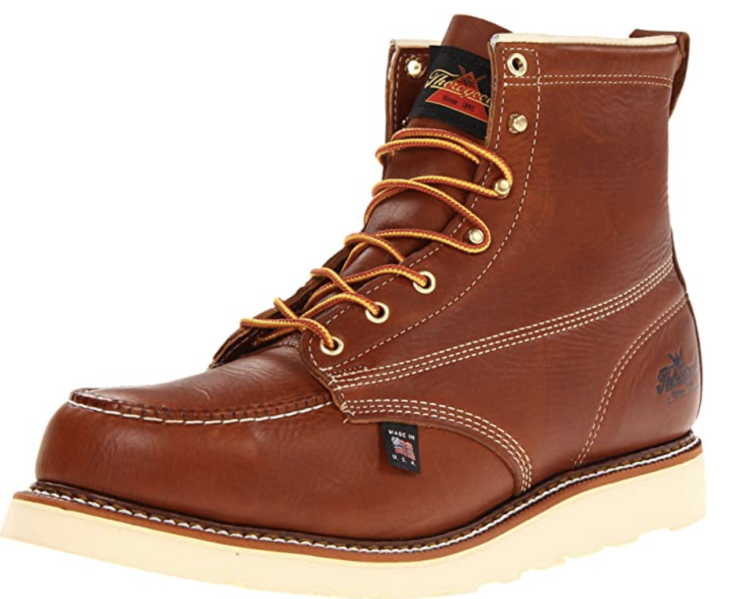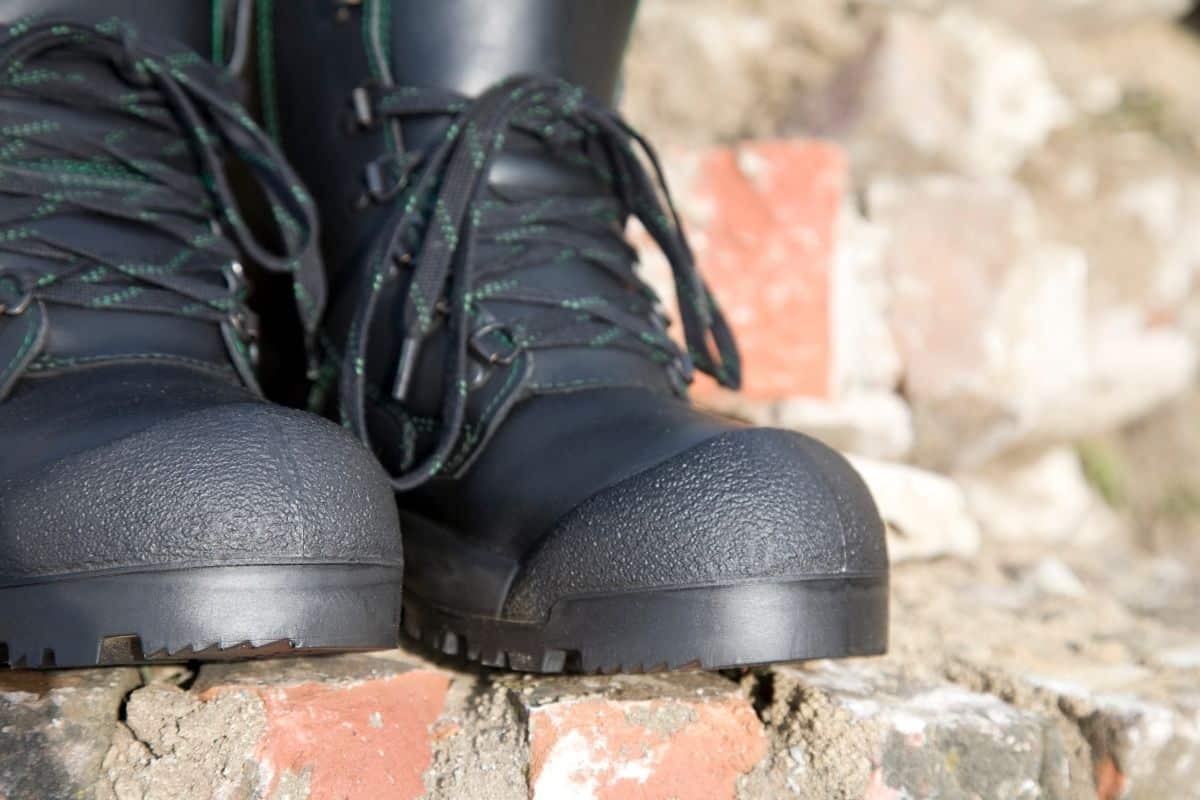Are you working long hours on hard concrete floors and feeling the toll on your feet? Look no further!
This guide will help you find the perfect work boots for concrete floors to ensure comfort and protection for your feet all day. With this guide, you can find the perfect pair of boots for your needs and ensure a pain-free workplace experience!
According to the Occupational Health and Safety Administration, having the right footwear can help protect workers from potential hazards in the workplace, such as slips and falls on wet concrete floors. The selection of a proper pair of work boots is made even more important if one stands for long hours on concrete floors during their daily job routine.
The following guide provides information on the different types of work boots available and what factors should be taken into account when purchasing such footwear. It also explains how to care for work boots and keep them in great condition for longer. Furthermore, it highlights some key considerations that you should make when picking out a pair of shoes suitable for working on concrete floors. Ultimately, reading this guide could help you find a boot that combines comfort with protection while still lasting through your whole shift without causing any unnecessary foot fatigue.

Importance of wearing proper work boots on concrete floors
Working on concrete floors can be physically demanding and dangerous. The surfaces are hard, often cold and unforgiving, and the amount of physical stress they can impose on the body is huge. If you spend all day on your feet working on a concrete floor, the right work boots are essential to keeping your feet healthy, dry, warm and protected – not only protecting against fatigue but also preventing injuries.
The right work boots have cushioning which absorbs shock of walking on hard surfaces, have treads that grip the floor and provide traction; they also insulate against cold temperatures and protect against slipping by providing waterproofing. Additionally, choosing the correct size is critical; having too small a boot will cause cramping in your toes as you move around during long shifts–as well as give way to injury should a heavy object drop or there is any kind of unexpected movement or impact.
Finally, it’s important to choose the appropriate style – whether it’s insulated boots for icy winter conditions outdoors or safety toe work boots for heavier machinery indoors; doing so will ensure additional protection for your feet in any type of environment.
Benefits of comfortable and protective work boots
Comfortable and protective work boots are vital to anyone who spends a significant amount of time standing on hard surfaces. By providing improved stability and cushioning, these shoes can prevent fatigue, reduce back strain, and decrease the risk of slips and falls. Good work boots also protect workers from hazards such as dangerous chemicals, sharp objects, extreme temperatures, electric shocks, and slipping on wet or icy floors. In addition to physical safety risks on the job site, comfortable and protective work boots can also reduce emotional stress caused by long hours spent standing or walking.
A good pair of comfortable and protective work boots should offer superior arch support while providing cushioning in all the right places. Features such as dual-density rubber foam soles with extra grip can prevent slips on wet concrete floors. Additional benefits often found in top-rated work boots include oil-resistant outsoles for slippery surfaces, toe protection from compression hazards, impact-resistant composite toes for added safety against heavy items falling from above shock absorbance features to reduce strain on lower body joints. For cold environments,many companies now offer insulated options for better protection against icy floors as well as insoles made with breathable yet waterproof materials to keep feet warm in winter months. It is important to research the best options available before making a purchase decision since some types of footwear may not meet certain workplace safety regulations or provide inadequate levels of protection even if they appear suitable for the task at hand.
Overview of the guide
Working on concrete floors requires footwear that not only offers protection but also comfort and mobility. In the following guide, you’ll learn what types of boots are ideal for long hours spent on hard concrete.
We will consider two categories of work boots both designed with performance and safety in mind—steel toe work boots and lightweight work shoes. These options provide protection, grip traction, support, and stability while also helping to absorb shock from impact.
We’ll provide an overview of the features to look for when buying a boot or shoe as well as considerations around fit and size to ensure optimal comfort no matter how long you have to stand in one spot. Read on for our complete guide for choosing workplace footwear for concrete floors.
Factors to consider when choosing work boots for concrete floors
When it comes to choosing the right work boots for concrete floors, comfort and protection are of paramount importance. There are a few factors to consider when selecting the best pair of boots for your specific job.
Footwear should provide adequate cushioning so your feet don’t become fatigued from standing on hard surfaces all day. Support around the ankle and arch is key for relieving pressure on the feet. Heavy-duty soles made with thick rubber or polyurethane can help absorb shock from concrete floors and prevent slips and falls. Look for tough materials such as leather or synthetic uppers for added durability and water resistance in wetter conditions. Slip-on styles might be more comfortable when working in an environment where you will constantly be required to bend over.
The fit can also affect how well a pair of work boots performs on concrete floors—look for ones that aren’t too tight but aren’t too loose either; they should fit snugly without constricting or rubbing uncomfortably against the foot while allowing unrestricted movement. Insoles may be needed to give extra cushioning if needed, making sure not to get ones that are too thick or wide which might cause the foot not to fit correctly into the boot itself nor cause discomfort due to excessive bulkiness inside your shoes after a long day’s work on rough surfaces like concrete floors.
Safety features
When selecting work boots for concrete floors, safety should be one of the most important considerations. The right safety features can help protect workers from the dangers associated with concrete floor operations, such as slips, trips and falls, which can result in minor to serious injuries.
Most work boots designed for use on these types of surfaces come with a variety of features that increase the wearer’s protection. Common features include toe caps to protect against blunt force impacts, heel counters for extra stability and shock protection and non-skid soles to reduce the chance of slipping or tripping on smooth surfaces.
It is also important to select a boot that fits properly; if it is too large or small it can lead to discomfort and improper protection. Look for boots that are made with breathable materials, such as leather and mesh, so your feet remain comfortable throughout your shift.
Comfort features
The comfort of work boots is important when working in concrete floors, specifically cushioning, padding, and orthotics. Cushioning gives the feet some sort of shock absorbent materials so when taking a step you are not getting the full brunt of the impact. Padding is important because it will give extra support to your feet all around the shoe, adding comfort and stability. Orthotics are inserts that are meant to relieve any pressure while also providing more support to different parts of your foot as needed.
Each type of boot has its own unique features for providing both comfort and protection that should be considered. Look for features such as cushioned insoles for shock absorption, breathable uppers for air circulation and padded collars or tongues for added comfort as well as removable footbeds for adjustable levels of cushioning and support. Work boots with rubber outsoles will provide good grip on wet or slippery surfaces and good insulation from electric shock too. Some boots come with steel toes and reinforcements which provide greater safety from impacts against hard surfaces or hard objects such as falling tools; these must be certified to ASTM F2413-11 standards before they can legally be sold in the US and Canada.

Maintenance and care of work boots for concrete floors
It’s important to ensure that work boots for concrete floors are properly cared for in order to ensure their longevity and that they provide the safety and comfort needed. Proper maintenance of work boots should include:
- Checking the sole often – Make sure the midsole, outsole, and toe box are not worn-down or scuffed. If any of these areas have become worn, this can potentially increase the risk of slipping or tripping hazards.
- Cleaning regularly– Regularly cleaning your work boots is important to prevent any built up dirt particles from getting in between the exterior and interior of the boot which could lead to decreased comfortability. Depending on how often you wear your boots and what type of environment you expose them to (i.e construction sites vs manufacturing plants) will determine how frequently you should be cleaning them (anywhere from daily if working in a high debris area, weekly if mild debris areas). Removal of dirt particles should always be done using a damp towel or cloth with mild soap; never submerge your work boots in water as this could cause permanent damage from excess moisture. Note: always check manufacturer’s instructions for detailed cleaning instructions as different materials require slightly different processes!
- Oil your leather– If working with leather boots make sure to oil them regularly as this helps improve their durability by keeping it water resistant which ultimately prevents cracks and dries outs. The best material for oiling leather is mink oil however other types of oils such as vegetable oils can be used as well; just note that different materials require different amounts so aim for one or two drops per layer rather than adding too much all at once – it is better to add multiple thin layers rather than one thick coat!
Cleaning and drying techniques
Equally important to choosing the right work boot for concrete floors is following a routine cleaning and drying program. Of course, boots get dirty and wet during normal use, so it is important to keep them clean and dry in order to maximize their life span.
Here are some key steps to ensure that your work boots remain in top condition:
- Brush away dirt particles and debris immediately after exiting the worksite; this will help avoid more serious damage throughout the day.
- Remove any mud or sticky materials from uppers using a soft brush and cool water.
- Ensure that all areas of your boots have been cleaned of all dirt, mud, grease or other residues; this should be done as frequently as possible.
- After each wear, stuff your work boots with newspaper sheets or toilet paper rolls to help create good airflow and remove moisture from inside the boot which can cause odor and instability over time.
- If your boots become overly wet or muddy, allow them to air dry rather than using heat from a radiator or stove—extreme heat can reduce the life span of quality materials like leather used in many types of working footwear.
- Utilizing an enzymatic cleaner during more circumstances can help remove odors effectively while also keeping bacteria at bay; be sure that any product used is appropriate for leathers or fabrics utilized in these shoes.
Storage tips
When not in use, it’s important to store your work boots properly to ensure they remain in perfect condition. Follow these simple steps when storing your work boots:
- Use a soft brush or damp cloth to clean the exterior of the boot, taking care not to rub too hard as this can damage the leather.
- Stuff with newspaper, tissue paper, etc., when storing and never store leather boots unlined or half-filled as this can cause them to become misshapen and ruin their shape.
- Store leather boots upright and preferably filled with cedar balls or cedar chips instead of tissue paper as cedar has natural antimicrobial properties which will help keep your boots smelling fresh for longer periods of time.
- If possible, try to store the boots in a cool dry place away from direct heat sources such as radiators, fireplaces and direct sunlight – both sunlight and heat tend to cause leather to dry out and crack over time.
- If you have mildew on any part of your boot due to a long period of storage, try using a gentle solution such as white vinegar mixed with warm water applied with a soft brush, which should remove mildew without drying out or breaking down the leather of the shoes in any way (but always check first on an inconspicuous area).
Regular inspection and replacement guidelines
It’s important to inspect your work boots regularly to see if they need replacing. Signs of deterioration such as visible damage on the sole, wear on the heel and midsole, reduced breathability of the lining or a weakened water-resistant properties should all be taken into consideration when deciding whether or not to replace your boots. However, in general it is recommended that you replace any work boots designed for concrete floors after 8-12 months of regular use. Budget accordingly!
After every use, it is also important to perform a full ‘kit check’, making sure that all laces are tightly secured, eyelets are free from obstruction, and any additional padding or inserts are securely fastened. If at any point you feel like any element may be damaged or have started to break down, then be sure to address it as soon as possible!

Conclusion
In conclusion, work boots for concrete floors should provide comfortable support while protecting your feet from the hard surface, helping to keep you safe and productive during long hours on the job. The right pair of work boots not only fit well and are comfortable, but also offer the protection and traction needed for specific job conditions.
There are several factors to consider before purchasing a pair of work boots for concrete floors, such as weather conditions, traction needs, sole durability, type of upper material and much more. As you weigh your choices in work boots for concrete floors, be sure to consider the top pick we have chosen for comfort and protection: Cat Footwear Men’s Argon Hi Comp Toe Shoe.
This boot offers good ankle support with a protective composite toe cap to protect sensitive areas from structural fall hazards or crush injuries. Its waterproof leather upper material is designed to keep moisture out of your foot in wet or rocky job sites without compromising durability or flexibility.
With its slip-resistant Opti-Grip outsole design and OrthoLite cushioning technology in each step, this shoe keeps your feet secure even in unpredictable terrain while providing added level of cushioning throughout long days on the job.
FAQ’s
What boots are good for standing on concrete all day?
Boots with good cushioning and support, such as those with memory foam insoles, rubber soles, and arch support, are good for standing on concrete all day.
What is the most comfortable boot for working on concrete?
Boots with ample cushioning and shock-absorbing soles, like those with EVA foam or gel inserts, are generally considered the most comfortable for working on concrete.
Are work boots good for standing all day?
Yes, work boots are typically designed for durability and comfort, making them a good option for standing all day. However, it’s important to choose a pair with good cushioning and support.
What is the most comfortable work boot for bad feet?
Work boots with orthotic inserts or those designed specifically for people with foot problems, such as those with wider toe boxes or extra arch support, are often the most comfortable for those with bad feet.
What are the best shoes for standing 8 hours a day?
Shoes with good cushioning, arch support, and shock-absorbing soles, like athletic shoes or those designed for walking or running, are often the best for standing 8 hours a day.
What are the best shoes for standing 8 hours?
The best shoes for standing 8 hours are those with ample cushioning, good arch support, and shock-absorbing soles, such as athletic shoes, walking shoes, or work shoes designed for standing.
What’s the best boots for concrete floors?
Boots with rubber soles, ample cushioning, and good arch support are generally considered the best for concrete floors, as they help absorb shock and reduce foot fatigue.
Which shoes are best for concrete?
Shoes with good cushioning, arch support, and shock-absorbing soles, such as athletic shoes or work shoes designed for standing on hard surfaces, are best for concrete.
How can I make my boots more comfortable for standing all day?
You can make your boots more comfortable for standing all day by adding cushioning inserts or orthotic inserts, wearing moisture-wicking socks, and taking regular breaks to stretch your feet.
What is the longest lasting concrete?
The longevity of concrete can vary depending on factors such as the mix design, construction methods, and environmental conditions. However, high-quality concrete with proper maintenance can last for decades or even centuries.
See Also :
- Best work boots for ankle support 2023
- Best work boots for asphalt 2023
- Best work boots for welders 2023
- Best work boots for back pain 2023
- Best work boots for bad knees 2023

